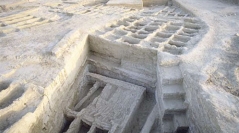

 Comptes Rendus Palevol
5 (1-2) - Pages 463-472
Comptes Rendus Palevol
5 (1-2) - Pages 463-472In different areas of continental India, many Mesolithic sites have been recorded. But it is with the discovery of Mehrgarh, excavated by a French archaeological team from 1977 to 2000, that, for the first time, on the western border of the Indus valley in Balochistan, Pakistan, a process of neolithisation, whose beginning can be dated to the 8th millennium BC, has been evidenced. Zooarchaeological and palaeoethnobotanical studies provide evidence of the setting of a true farming economy in a large-sized settlement with buildings in mud bricks obeying rather standardized plans. The gravegoods of the successive graveyards in the course of the 7th millennium BC bear testimony of the high quality of the craft activities. The pollen analyses and the anthracological studies support the assumption that the vegetation in the Neolithic period was related to climatic conditions probably different from those prevailing today.
Indian subcontinent, Balochistan, Neolithic, domestication, vegetation, pollens, climatic conditions, cemeteries, crafts, figurines